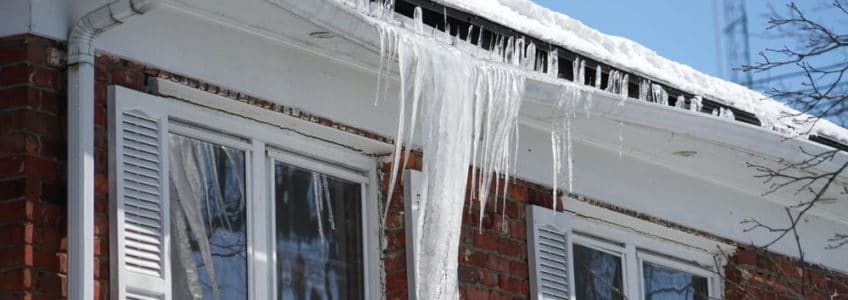
Minnesota snow storms bring beautiful winter scenes, including long, sparkly icicles hanging from the roof, and families drinking hot chocolate together after a day playing in the snow. But as a Midwest homeowner, what you may not know is that those icicles signal that ice dams are likely forming on your roof. So, what is an ice dam? How do they damage your home, and what can you do to prevent them? Let’s read on.
How Do Ice Dams Form?
Ice dam formation isn’t simply a ventilation issue within roofing and attics, but also home energy. Ice dams are caused by warm, moist air in your attic that melts the snow underneath. The melted snow then runs down your roof forming ice dams and icicles when air conditions are just right.
Warm Attic Air Rises Quickly
When the outdoor temperatures get cold, the water molecules in the air lose energy meaning the molecules moving through the cold air don’t move as fast. However, the warm, moist air in your attic allows water molecules to move quickly resulting in leaks around plumbing vents, chimneys, and electrical wires which all warm the underside of your roof.
Melted Snow and Icy Air Don’t Mix
You may notice that only part of your roof is free from snow. That’s where the warm, moist, rising air in your attic seeps underneath your roof to melt it. However, the melted snow doesn’t stay in one place or simply run off your roof or through your gutters. When the temperature of the air is below 32 degrees, the melted snow begins to freeze when it hits those sections of your roof resulting in ice dams and icicles over time.
Ice Dam Damage You Will Eventually See
These ice dams cause water to back up under your shingles which, in turn, damage your roof. Worse still, water can leak into your home’s ceilings and walls causing costly interior damage. So although icicles hanging off your roof make for a pretty picture, they can be quite damaging to your home, making it vital that you stop ice dams before they start.
Steps to Prevent Ice Dams on Your Home
The key step to ice dam prevention is to control the heat loss from your home. Just by the nature of structural integrity due to aging, older homes are more likely to develop ice dams than new builds. If you’re having issues with ice dams, you may want to consider an energy assessment to determine how well the insulation is doing its job.
Find Your Attic’s R-value
Proper insulation for both old and new homes must have a minimum resistance-value (R-value). The R-value of insulation tells you how much heat you will lose or maintain. It’s the rating system for insulation products. The minimum R-value for new construction insulation is 49. For homeowners in Minnesota, you will want to target a 49 to 60 R-value. The higher the R-value, the more effective your insulation. Depending on where you are located in Minnesota, you may be in zone 6 or 7, with zone 7 being the coldest area needing the most insulation and higher R-value.
Older Homes
Generally any home that is over 50 years old is considered an older home, and below are a few suggestions for preventing ice dams from occurring:
- Get a professional energy assessment to determine your R-value
- Keep your home well-insulated to prevent mold, mildew and respiratory problems
- Increase ventilation
Older homes settle as they age like any home. Preventative maintenance, fixing cracks, replacing fixtures, and adding insulation will help you keep ice dams at bay.
Newer Homes
Your home won’t pass inspection if you don’t meet the minimum R-value for new construction (49). There should be no air leakage from your home’s living spaces to the attic. Minimize the risk of ice dam damage by sealing skylights, avoiding excessive recessed lighting, and keeping roof structures simple, but not flat.
Short-Term Solutions for Ice Dam Damage
For a non-emergency fix:
- Remove as much snow off your roof as safely possible
- Roof rakes must be used carefully as not to damage shingles
Emergency interior home water leakage:
- Create a channel in the ice dam to release water back-up behind the dam
- Maintain safety at all times
- Stop the leakage before it seeps into your home’s electrical system
Long-Term Solutions for Ice Dam Damage
- Make sure that your home’s attic is well-sealed through pathways that can leak air
- Set your home’s thermostat at the proper humidity level
- Maintain uniform roof surface temperatures
What About Homeowners’ Insurance?
Although most homeowners’ insurance won’t cover ice dam removal, it will cover ice dam damage like roof collapse due to the weight of snow and ice. No two insurance companies are alike, so be sure to get in writing what type of ice dam coverage your particular insurance provider covers.
Advantage Construction: Your Ice Dam Damage Experts
Ice dam damage costs both money and lives. Not only to roofs, gutters, ceilings and walls, but electrical systems causing fire hazards. Here at Advantage Construction, we are familiar with Minnesota winters and the havoc wind, snow, ice and freezing temperatures can create. If you have been searching for a qualified ice dam removal expert, we encourage you to contact Advantage Construction today to speak to our team of professionals.
